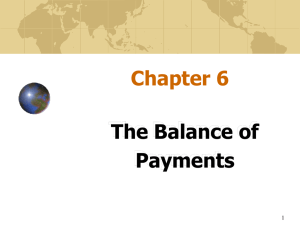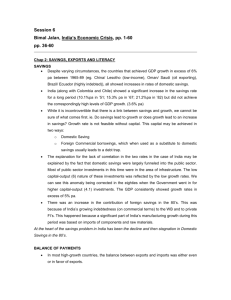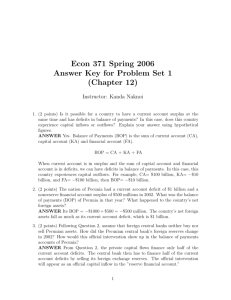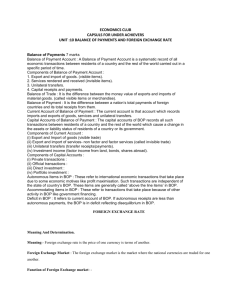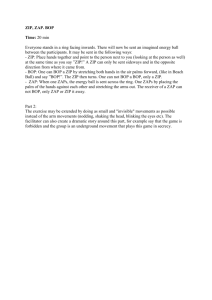Project Initiation Document - Office for National Statistics
advertisement
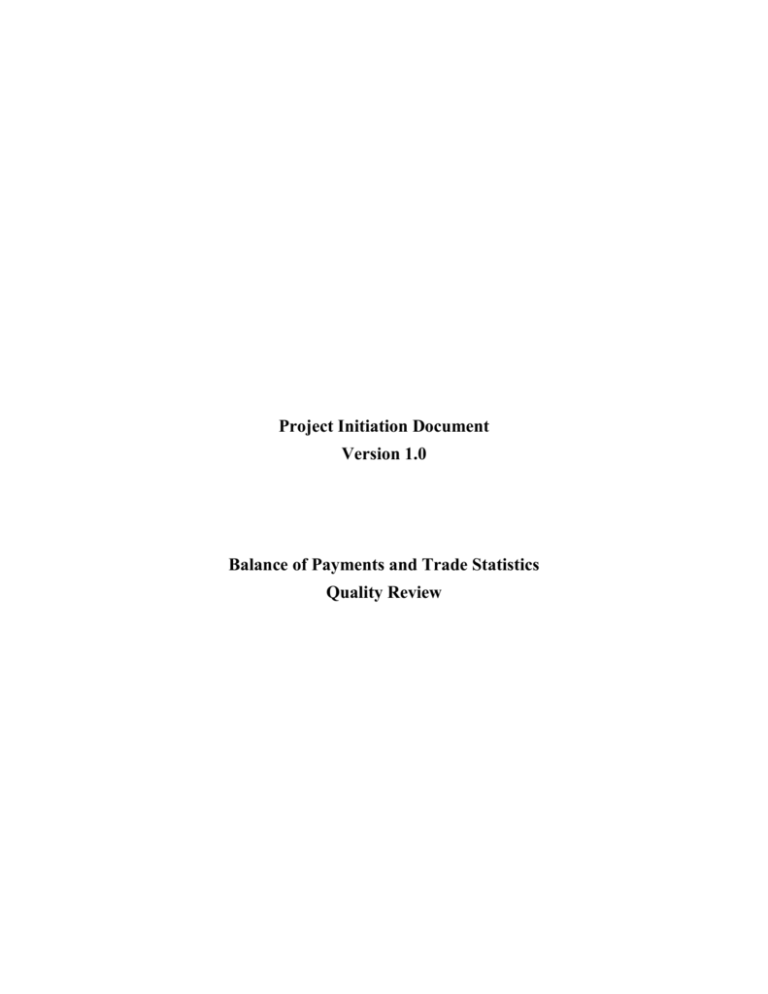
Project Initiation Document Version 1.0 Balance of Payments and Trade Statistics Quality Review Contents 1. Introduction 1.1 Background ..........................................................................................................................3 1.2 Outputs .................................................................................................................................3 2. Project Definition 2.1 Objectives ............................................................................................................................4 2.2 Method of Approach ............................................................................................................4 2.3 Scope ................................................................................................................................ 4-5 2.4 Exclusions from Review Scope ...........................................................................................6 2.5 Deliverables and Desired Outcomes ....................................................................................6 3. Initial Business Case 3.1 Reason for Review ...............................................................................................................6 3.2 Expected Business Benefits .................................................................................................7 3.3 Costs and Timescale ........................................................................................................ 7-8 4. Type of Review .................................................................................................................................8 5. Organisation Structure 5.1 Quality & Methodology Programme Board ........................................................................8 5.2 Theme Working Group .................................................................................................... 8-9 5.3 Review Board.......................................................................................................................9 5.4 Review Team .......................................................................................................................9 6. Communication Plan 6.1 Interested Parties ................................................................................................................10 6.2 Information Required .........................................................................................................10 6.3 Method of Communication ................................................................................................ 10 6.4 Frequency of Communication............................................................................................10 7. Consultation Plan ...........................................................................................................................11 8. Quality Assurance Plan .................................................................................................................11 9. Review Plan 9.1 Gantt Chart ................................................................................................................... 11-12 10. Evaluation .....................................................................................................................................13 11. Review of Risks ............................................................................................................................13 12. Contact ..........................................................................................................................................13 Annex A.............................................................................................................................. 14-20 1. Introduction 1.1 Background With the launch of National Statistics, the principle of all key outputs being subject to quality reviews was established. The Government's white paper Building trust in statistics, highlighted the need for a programme of quality assurance through a series of reviews. The following Project Initiation Document (PID) forms the basis for the review of Balance of Payments and Trade Statistics. 1.2 Outputs Balance of payments and Trade statistics are key macro-economic indicators covering information collected and published by HM Customs & Excise, and the Office for National Statistics. The statistics measure economic transactions between United Kingdom residents and the rest of the world. As a member of the international community, the UK follows international standards relating to balance of payments and international investment position (BoP&IIP) statistics based on the conceptual framework of the IMF Balance of Payments Manual - Fifth Edition, and merchandise trade statistics based on the UN's International Merchandise Trade Statistics- Concepts and Definitions (IMTS). Conforming to the international frameworks ensures: that the UK's official BoP&IIP statistics comply with objective, coherent international standards that reflect current global analytic needs. that data are suitable for comparison and reconciliation between countries. As well as appearing as a separate output, balance of payments and trade appears as the rest of the world sector within the national accounts. The main components that make up balance of payments and trade, include: exports and imports of goods exports and imports of services income flows transfers financial flows As part of the presentation of balance of payments, the international investment position (IIP), a closely related set of statistics, measures the UK's stock (or level) of foreign financial assets and liabilities at a particular date. Data are also produced on a geographical basis ranging from an annual breakdown of the current account transactions with sixty-five countries, to a quarterly breakdown with European Union and Non-European Union countries, USA, Japan and Canada. The bop & trade review aims to cover quality issues relating to the outputs discussed above. Some information, such as price indices and volume measures are, out of the scope of the review due to the size of the output and the resource available to complete the review. 3 2. Project Definition 2.1 Objectives The main objectives of the BOP & Trade quality review are to: confirm whether statistics are fit for purpose. identify areas where they are not. specify realistic, achievable action plans, and address each identified area. To do this, we need to decide on the best type of review to conduct based on the characteristics of BOP & Trade statistics. Once the review type has been established, the main aims will be to consult with users and stakeholders to gain a wider view on the quality of the statistics currently produced. This will confirm whether current outputs are fit for purpose and identify areas for development based on the feedback received. 2.2 Method of Approach The review will be conducted according to the guidelines issued by the ONS quality review programme support team. See website for details; http://www.statistics.gov.uk/methods_quality/quality_review/downloads/Review_Guidance_reworked_v1.2.doc 2.3 Scope Balance of payments and trade statistics has been split into six broad categories for the purpose of the review. Within these areas, we will aim to identify the main uses of the statistics and determine whether the current outputs satisfy user needs, as well as identify whether the current inputs and key outputs are of an adequate quality. In line with Eurostat's approach, quality in this case encompasses: Relevance - The appropriateness of the statistics to the users' needs. Accuracy - The ability of the outputs to closely match the actual value of the outputs being measured. Timeliness - Latest estimates, concepts and methodology being published to a timetable mutually agreeable to stakeholders, users and suppliers. Accessibility - Data that are easily accessible to users in the form they desire. Data include, documentation and guidance in interpreting the statistics. Comparability - Data are most useful when we are able to make comparisons over time and between countries producing similar statistics. Coherence - Since balance of payments and trade statistics originate from various sources, we need to ensure that the statistics are based on common definitions, classifications and methodological standards. Where this is not possible, we need to explain clearly any differences in compilation. Completeness - Statistics should not only be appropriate to users' needs, but should try to serve those needs as fully as possible given restricted resources. 4 It is important to point out that there is a trade off between quality considerations. The most obvious example is the trade off between timeliness and accuracy. Therefore, we are aiming to achieve the correct balance between the quality items discussed above. We will also ensure that methodologies used to produce the statistics are in line with best practice. The main areas that the review will cover are: Merchandise Trade (and BoP Trade in goods) Trade in Services Income Current Transfers Financial Account International Investment Position For an indication of the suggested scope of the quality review for these statistics, see Annex A. 2.3.1 IMF Data Quality Assessment Framework (DQAF) We have completed a draft self-assessment of UK Balance of Payments using the IMF DQAF. It is not a final document and we would like to keep updating and fine-tuning it in line with the Quality Review. We will include it with the Quality Review main documents on the website and we would welcome comments on it from users and suppliers and BoP compilers. 2.3.2 Current prices Balance of Payments is measured in current prices only. Components within trade statistics are also calculated at constant prices for GDP purposes. Due to the size of the data set involved and the timescale, the review would not be able to cover all of the issues relating to current and constant prices, so the review is planned to concentrate on current price outputs only (see exclusions, Section 2.4). 2.3.3 Survey data A large number of inputs are based on survey data, from a wide variety of sources. The review will aim to investigate the use and application of survey data in the compilation of balance of payments and trade statistics. Data suppliers including, the Bank of England, HM Customs & Excise, ONS business surveys and private companies who survey members on behalf of the ONS will be included in the scope of the review. Detailed ONS survey methodology is covered by a programme of regular reviews and so falls outside the scope of this review, although in some cases user consultation could still influence these inputs. 2.3.4 Data management The systems used in the compilation of statistics play a major role in determining the quality of key outputs. As part of a wider programme looking into the efficiency of ONS systems, the review team will appraise the current systems used to generate outputs. 5 2.4 Exclusions from Review Scope The assurance of a number of areas within balance of payments and trade statistics lies outside the scope of this review. 2.4.1 Derived Trade in Goods products Currency of Invoicing is a product derived from Trade in Goods statistics that is not classed as a National Statistics output. Whilst user needs of this output may be identified during the course of the review, the quality of the methodology and output lie outside the scope of this review. 2.4.2 Prices and volume Prices and volume cover specific issues that impact on trade statistics. Due to the size of the data set involved in the BoP and trade statistics review, it is not planned initially to spend a lot of time investigating the compilation of constant price estimates and the indices used. However, we will record any strong views users may have on this issue, and review the scope after the consultation exercise. Work to develop export and import prices will continue in any case, particularly within the Eurostat programme to improve deflation methodology. A National Statistics Quality Review on Deflation is planned in the future. 2.5 Deliverables and Desired Outcomes A measure of the review's progress and success will be the achievement of specified desired outcomes by the due dates. These deliverables will be quality assured through regular feedback (see sections 6 & 7). The desired outcomes from the review are: A list of issues to explore in more detail (end September). A list of options detailing how we might improve the quality of BOP & Trade statistics (end December). Final report on quality (end February). Implementation plan (end March). Some of these outcomes may feed into subsequent reviews. 3. Initial Business case 3.1 Reason for Review The review of balance of payments and trade statistics is part of the wider National Statistics programme of quality reviews. 6 3.2 Expected Benefits Carrying out the quality review will identify areas for development and ensure that bop and trade statistics are fit for purpose. The review will also ensure that the business areas responsible for generating outputs, support the principle of continuous improvement to the quality and value of key outputs. 3.3 Costs and Timescale The review takes place over the financial year 2002/03 based on the following outline: Consultation with users, stakeholders and other interested parties (June 2002 - September 2002). Undertake investigations, develop options and discuss with users and stakeholders (September 2002 - end December 2002). Final report with recommendations (January 2003 - end February 2003). Initial implementation plan (February 2003 - end March 2003). There is no separate funding for the review. Costs will be covered within current budgets. 3.3.1 Draft Project Initiation Document (PID), including scope of review (end June) The scope of the review, included in the project initiation document, will be drafted and agreed by the review team, sent to the Economy Theme Working Group for comment, then presented to the review board for approval. 3.3.2 First meeting of the review board (July 2002) The main objective of the first meeting is to approve the draft project initiation document and in particular, the scope of the review. Once the PID has been agreed, it will be published on the National Statistics website. 3.3.3 Consultation with users, stakeholders and other interested parties (June 2002 - September 2002) An outline plan of the consultation process is given in section 6 of this document. The review team will seek feedback from users and stakeholders who have an interest in their particular area of work. Responses will be co-ordinated for appraisal by the review team before the next phase begins. No evaluation will take place at this stage, simply an analysis of the responses received. 3.3.4 Develop options and discuss with users (September 2002 - end December 2002) Within this stage, there will be a review board meeting to discuss the main issues identified, and to discuss the approach we intend to take to address these issues. Users and stakeholders will be consulted regarding the initial options proposed. Once they have been agreed with interested parties, the review board will be asked to agree the final set of options prior to the initiation of the next stage. 7 3.3.5 Produce final report (January 2003 - end February 2003) The review team will prepare a draft of the final report, including a summary of the recommended course of action. The report will be circulated to the review board for final approval, at the start of February, before presentation to the National Statistician. Final report - The final report will be published on the National Statistics website. 3.3.6 Implementation plan (February 2003 - end March 2003) Within three months of publication of the final report, a plan to implement recommendations highlighted in the report will be made available on the National Statistics website. 3.3.7 Costs Resources allocated to carry out the review will be found within current budgets. Given below is a profile of staff resources needed, over an eight-month period, based on monthly input to the project. 0.05 X 1 Project Sponsor 0.025 X 8 Review Board Members 0.4 X 1 Review Manager 0.1 X 4 Review Team Members 0.1 X 1 Review Support Person 4. Type of Review The review has been allocated as a Standard review, which applies to key outputs of major importance, where the purpose of the review is to ensure that the statistics are of a good quality and are fit for purpose. For further details see guidance notes. 5. Organisation Structure 5.1 Quality and Methodology Programme Board (Q&MPB) The Q&MPB is responsible for managing the national statistics quality assurance programme. Its role has been to establish and keep under active review an effective system for quality assuring National Statistics outputs. 5.2 Theme Working Group (TWG) All official statistics, which come within the scope of National Statistics, have been allocated to one primary 'Theme'. There are twelve themes in all, and each theme is managed by a Theme Working Group which, amongst other tasks, is responsible for planning and scheduling a programme of reviews covering the 8 theme's main outputs. The Economy Theme Working Group has scheduled the balance of payments and trade statistics quality review. Since HM Customs & Excise statistics fall under the Economy theme and the Commerce, Energy & Industry (CE&I) theme, the CE&I TWG will have input into the project. 5.3 Review Board Responsible for overseeing the work of the review team, the review board's main function is to provide strategic direction and quality assurance for the review. The review board will manage available resources to ensure that the review meets its objectives according to the timescale set out in the quality review guidelines. Members Stuart Brown Peter Matheson Anand Mehta Duncan McKenzie Carole Rennie Graeme Walker Simon Whitaker Sandra Tudor David Canham Organisation ONS, BOP Division HM Treasury DTI, UK overseas trade & current a/c International Financial Services, London (IFSL) ONS, BOP Division ONS, Financial and Accounting Surveys Bank of England HM Customs & Excise ONS, project guidance Role Project Sponsor Senior User Senior User Non-Government User Review Manager Senior Supplier Senior User Senior Producer Correspondence member Main responsibilities of the review board are to: agree project's scope. provide an external perspective. take into account wider issues relating to the programme and work area involved. quality assure the review process. 5.4 Review Team The review team is responsible for delivering outputs identified by the review board. The review requires substantial input from the business area teams responsible for the output (hence the make up of the team), particularly in providing data, details of methodology and the underlying principles. The review team will be fully involved in establishing the options for change and in determining relative merits. Members Carole Rennie Simon Humphries David Ruffles Jennie Tse Sharon Hudd Organisation ONS, BOP Division ONS, BOP Division ONS, BOP Division ONS, BOP Division HM Customs & Excise, SATU 9 Role Review Manager BOP&IIP Statistician Trade in goods Statistician Trade in services Statistician Merchandise Trade Asstn Statistician 6. Communication Plan 6.1 Interested Parties The communication plan for the bop & trade review aims to identify all stakeholders outside the review team and agree information needs, including frequency and methods of communication. The review team will disseminate information through various channels. The table below summarises the communication plan. 6.2 Information Required Stakeholders Review Team Review Board Theme Working Group Other Interested Parties Website users Project Initiation Document (PID) * * * By Request * Review Reports * By Request By Request Review Board Final Minutes Report * * * * By Request * By Request * * Implementation Plan * * * * * 6.3 Method of Communication Main documents will be made available on the National Statistics website under quality review for the economy theme. A series of presentations to major users and stakeholders will take place to inform them of the balance of payments and trade statistics review project. Review Board meetings will be managed by exception to minimise the burden on members. The first meeting will be convened to confirm agreement of the PID before it is made available on the website. Further meetings will be arranged to sign-off the end of a review stage and commission the next stage. The consultation process will involve mailing information and a questionnaire to identified users and suppliers within and outside of government. Personal interviews may also be used as part of the process. 6.4 Frequency of Communications Presentations for major users and stakeholders will be held to coincide with user group and departmental liaison meetings. A maximum of four review board meetings will be held throughout the life of the project. Additional meetings will only be convened if there are exceptional issues to discuss. A mailshot containing a questionnaire and background information will go out to users, follow up actions will be based on replies to the initial contact. 10 7. Consultation Plan Bearing in mind that the main reason for the balance of payments and trade review is to assess whether the outputs meet user needs, it is vital that we seek input from a wide variety of users and stakeholders. The review team will compile a comprehensive list of users to be consulted, and will also consult with key users participating in various, relevant user groups, such as the Balance of Payments User Group and the International Trade Statistics User Group. 8. Quality Assurance Plan The quality plan specifies how the review team intends to deliver outcomes that meet users and stakeholders (the review board) quality expectations, and the quality standards set out by the National Statistics programme team. The BOP & Trade quality review will be run according to the guidelines set out by the Quality & Methods Programme Board. A member of ONS National Statistics Policy Division, David Canham (also secretary of the Economy TWG), will provide advice on practice and procedure. This will involve a Quality Assurance role and will help to ensure that this review draws on lessons learned from previous reviews. Issues will be discussed with users and stakeholders before progressing project stages. The review team will receive feedback from stakeholders, users, and other interested parties. The review board will oversee the process of consultation and development. The review board will contain at least one non-government independent external member. The following key documents will be made publicly available as the review progresses: The project initiation document which will include the scope of the review. The final review report, with response by the National Statistician. An initial implementation plan 9. Review Plan The review plan provides a description of how and when the project's objectives are to be achieved. The plan shows the major deliverables (see section 2.5), management stages and major control points of the project. See below. 11 Balance of Payments and Trade Statistics Quality Review Plan - (May 2002 to March 2003) May-02 Jun-02 Jul-02 Aug-02 Sep-02 Oct-02 Nov-02 Dec-02 Jan-03 Feb-03 Mar-03 1 2 3 4 1 2 3 4 1 2 3 4 1 2 3 4 1 2 3 4 1 2 3 4 1 2 3 4 1 2 3 4 1 2 3 4 1 2 3 4 1 2 3 4 OVERVIEW 1. Project Initiation Document (PID) produced by Review Team 2. Identify issues to be addressed and consult major users 3. Undertake investigations, develop options and discuss with users 4. Produce final report 5. Produce implementation plan DETAIL 1. PID produced by Review Team 1.1 PID discussed and produced 1.2 First meeting of Review Board 2. Identify issues to be addressed and consult with major users 2.1 Consult with user groups 2.2 Mail questionnaire to users/stakeholders 2.3 Chase replies to questionnaire 3. Undertake investigations, develop options and discuss with users/stakeholders 3.1 Investigate main issues in more detail 3.2 Discuss main issues with Review Board 3.3 Investigate detailed issues 3.4 Develop options to investigate an approach to highlighted issues 3.5 Circulate issues identified and options to the Review Board 3.6 Discuss options with users and stakeholders 3.7 Agree options with the Review Board 4. Produce final report 4.1 Produce draft report 4.2 Circulate to Review Board and stakeholders for final comments 4.3 Send to National Statistician 4.4 Final report published on website with National Statistician's comments 5. Produce implementation plan 5.1 Produce implementation plan Major milestones Project stages 12 10. Evaluation The review process will be evaluated at the end of the project by the Review Team and agreed by the Review Board. This will provide an additional quality assurance check of the project and may prove to be useful for impending reviews within National Statistics. Evaluation: Ensures that the aims and objectives set out in the PID have been met. Captures and disseminates lessons learned from the process. Records any follow-on recommendations that may lead to smaller, targeted reviews. 11. Review of Risks Risk No. 1 Description Likelihood Regular outputs take priority over the project. Medium 2 Scope of the review is Medium much larger than expected. Medium 3 Quality review meets the stated requirements but does not fulfil expectations. Review team and/or review board experiences staff changes. Low High Medium Medium/High 4 Severity of Effect Medium Countermeasure(s) Organise team so that resources are dedicated to the project for a specified time throughout its life. Carefully monitor the size of the review. Cover core issues in the main project, and conduct a smaller review, at a later stage, for less major issues. Ensure communication plan is adhered to. Receive regular feedback from users, stakeholders and other interested parties at each stage. Ensure project work is documented. Review sponsor will ensure that adequate resources are available to cover commitment to the project. 12. Contact If you have any comments or questions on the balance of payments and trade statistics project initiation document, please write to: Carole Rennie Office for National Statistics 1 Drummond Gate LONDON SW1V 2QQ Or email: carole.rennie@ons.gov.uk 13 Annex A Balance of Payments and Trade Statistics Initial Analysis of the Scope of the Review Introduction The review of balance of payments and trade statistics aims to provide answers to the following questions: Are user's requirements being met by the current set of outputs? Are there aspects of timeliness or cost effectiveness that can be improved? Are the inputs and methodologies used appropriate, and are they of sufficient quality to meet purposes? Is the burden on data suppliers justified and held at the minimum required level? Can the information on quality, which is available to users, be improved? Consultation with users' and stakeholders' is essential to the review of quality, and equally as important is the input from teams currently working to produce the statistics, who bring first hand knowledge of processes involved in delivering the key outputs. The summary below describes each area under review and presents first thoughts on the scope of the quality review. The issues mentioned are not exhaustive, but are provided as a guide for users and stakeholders. Users' are encouraged to highlight additional issues, which they consider important, that may not appear below. Overview We are committed to produce full balance of payments (BoP) accounts within thirteen weeks of the end of the quarter, consistent with the national accounts timetable. Other international users of BoP data, in particular the European Central Bank (ECB), require monthly estimates. The review will attempt to establish domestic awareness for currently produced monthly balance of payments. This review covers the components of the Balance of Payments and associated costs and quality across these components in response to user need. Methodology HM Customs & Excise (Customs) and the Office for National Statistics (ONS) have a large number of obligations to meet international standard definitions and requirements. Chief among these definitions and requirements are: European System of Accounts (ESA95) International Monetary Fund (IMF) Balance of Payments Manual Fifth Edition (BPM5) Standard Industrial Classification (SIC) Eurostat's Combined Nomenclature (CN) World Customs Organisation Harmonised System (HS) United Nations (UN's) Standard Industrial Trade Classification (SITC) UN's International Merchandise Trade Statistics Concepts and Definitions (IMTS) UN's Broad Economic Categories (BEC) ECB's balance of payments regulation and guideline UN's International Trade in Services Manual EU legislation for Intrastat and Third Country merchandise trade We are probably clearer about international requirements than domestic user requirements, because they are set out in documents covering international standards and regulations. Examples are given below: 14 (a) Eurostat requirements are clearly specified in the vade mecum and ESA95. An EU Regulation on BoP is being prepared. (b) The ECB also have specific issues regarding monthly balance of payments, which are defined in the BoP Regulation and Guideline. The review will assess domestic awareness of the current monthly BoP estimates. (c) IMF quarterly and annual requirements are defined in the Balance of Payments Manual - Fifth Edition. The International Statistical Community orchestrates changes in these requirements and definitions and the UK seeks to influence these as necessary. There are changes being introduced in the SIC from 1 January 2003. After that, the next significant changes are expected to be in 2007 when changes are being made to the HS - which will also affect the CN - and SIC. In addition, it is likely that the SITC and BEC classifications will also be revised at that time. An alternative to the BEC is Eurostat's Main Industrial Groupings (MIG) classification and it is possible that the UK will be required to produce data on this classification at some future date. Also, IMF has already begun the process of drawing up the sixth edition of the Balance of Payment Manual. Data collection In the UK, we compile our national accounts and BoP statistics simultaneously and together. BoP survey reporting costs are constrained within the whole national accounts compliance plan. Many survey forms collect BoP data as a subset of national accounts data. Cost effectiveness Release UK Balance of Payments - the Pink Book, as a web-based publication only, and consider the option of print on demand. The ONS has various Information Management (IM) initiatives such as the re-engineering of National Accounts systems, which will impact on ONS processing. Improvements Methodological notes in Pink Book could be improved. Merchandise trade Goods comprise most movable goods that change ownership between UK residents and non-residents. For detailed methodology follow link: http://www.statistics.gov.uk/themes/economy/Articles/BOP/bop_meth.asp An indication of users' needs of the output may include: Methodology 1. Eurostat is requiring all Member States to move closer to the IMTS definitions. Customs and ONS are working to implement the 'Specific movements Regulation'. Further work will be needed to identify remaining areas where Customs data does not meet the IMTS definition. 2. When ESA95 was introduced, the UK obtained a derogation from Eurostat regarding the treatment of non-monetary gold. This derogation expires on 1 January 2005, by which time the UK needs to have methodology in place and data available. 15 3. The UK will continue to monitor 'Mirror Statistics' of trade with other EU Member States on a regular basis, and to explore inconsistencies between the data and to take steps to improve the UK's data where it is found necessary. 4. Because of the value threshold in place to minimise the number of businesses required to submit detailed Intrastat returns, Customs estimates where the below the threshold trade should be allocated (to country and CN8 level). This methodology was devised in 1993 and may need to be reviewed to ensure accurate allocations continue. Requirements 5. As Candidate countries join the EU, back data for an enlarged EU will need to be produced in order to generate as far as possible, a consistent time series. This will not be easy as not all countries will join at the same time and some countries did not exist (in their own right) until the early 1990s. Data collection 6. Customs will look at the burden placed on businesses by the Intrastat system for collecting data with EU Member States. In addition, there are a number of areas where data may be viewed as weak and where alternative sources (perhaps involving new data collection) or methodology need to be researched. These include: Estimates of freight and insurance costs (including data collected by Customs Ancillary Costs survey) Trade with Channel Islands and Isle of Man Books by letter post 7. The Customs International Trade Blue print aims to facilitate trade, and improve the effectiveness of Customs controls. This may impact on the collection of non-EU trade statistics currently captured through Customs declarations. Any information generated by this review concerning the provision and use of nonEU data will be used to inform work currently underway in developing the Customs International Trade Blueprint. 8. A new Eurostat 'Short term Indicators' regulation is calling for directly collected export/import prices split between EU and non-EU trade. The main impact is on data collection in ONS Business Statistics Group (BSG) in Newport, but it will also impact on demands on Customs (to help with the development of the survey register) and Balance of Payments Division, within ONS. Cost effectiveness 9. Customs have various initiatives to make data collection and processing more efficient (for example, webform and NES, Customs Blueprint) and derive products such as regional trade estimates from existing data. 10. Need for, and content of paper publications (i.e. OTS suite of books produced by Customs) will be reviewed. Improvements 11. Customs and ONS should review the presentation of trade statistics to improve the transparency of the transition from Customs data to Balance of Payment data (currently in table 2.4 of Pink Book). They will make clear which adjustments are to improve conformity to the IMTS definition, which are to improve conformity to BoP definitions and which adjustments are made that do not fit either of these categories. This would also apply to methodological descriptions in a number of public documents such as Statistics on 16 Trade in Goods (GSS methodological paper), the Pink Book and the OTS suite of publications, and to all other media used to disseminate metadata on methodologies used in the compilation of trade statistics. Trade in services Services comprise services provided between UK residents and non-residents, together with some transactions in goods where, by international agreement, it is not practical to separate the goods and services components. For detailed methodology follow link: http://www.statistics.gov.uk/themes/economy/Articles/BOP/bop_meth.asp Methodology 1. Now that the Trade First Release has speeded up, trade in services estimates, that are normally available, sometimes have to be forecast. We need to ensure that forecasts are of sufficient quality. 2. Some survey processing/grossing methodology could be reviewed. We need to ensure that data collection and compilation is meeting national accounts and balance of payments needs. For example, consistent time series for annual and quarterly data. Requirements 3. When the BoP regulation is passed, Eurostat will require a more detailed geographical breakdown of annual and quarterly data, than is currently presented in the annual publication UK Balance of Payments and the quarterly publication Quarterly Balance of Payments. Data collection 4. Our provisional results from the Annual International Trade in Services (ITIS) survey are already much faster than most inquiries. However, some of our other inputs may well be able to be speeded up. 5. If we can get trade in services questions reclassified to "core" questions in the IPS survey, then we might be able to fund more questions, or run the expenditure trailer. Output from the expenditure trailer would be quite useful to assist with smuggling and cross border estimates. 6. We need to investigate and improve source data for freight rates and tonnage data, used in the calculation of transport estimates. 7. The Transport Technical Group has raised questions about both the quality and suitability of the Ancillary Costs Survey. Cost effectiveness 8. The "transport" processing system could be moved to the central shared database (CSDB), in line with other systems in national accounts. The Excel spreadsheets used to calculate transportation estimates are complex and therefore present a risk. Improvements 9. The United Nations International Trade in Service manual has some recommendations that we don't currently meet. The most important and difficult for us is the compilation of inward and outward Foreign Affiliates Trade Statistics (FATS). 17 10. Pink Book methodological notes and, the section on trade in services in the ESA95 inventory could be improved. Compensation of employees Compensation of employees comprises wages, salaries and other benefits earned by individuals from economies other than those in which they are residents, as well as earnings from extra territorial bodies such as foreign embassies, which often employ staff from the economy in which they are located. For detailed methodology follow link: http://www.statistics.gov.uk/themes/economy/Articles/BOP/bop_meth.asp Quality assurance 1. The quality of the data we currently have for foreign embassies based in the UK is weak because it is estimated using inquiry results obtained in 1993. We need to approach key commissions and embassies to update our inquiry results. Current transfers These transfers represent the offset to the provision of resources, between residents and non-residents with no quid pro quo in economic value, that are normally consumed with a short period - less than twelve months - after the transfer is made (for example, the provision of food aid). http://www.statistics.gov.uk/themes/economy/Articles/BOP/bop_meth.asp Quality assurance No specific issues identified. Capital account The capital account comprises both capital transfers and the acquisition and disposal of non-produced, nonfinancial assets. The latter includes land purchases and sales associated with embassies and other extraterritorial bodies. Capital transfers entries are required where there is no quid pro quo to offset the transfer of ownership of fixed assets, or the transfer of funds linked to fixed assets, or the forgiveness of debt. It also includes the counterpart to the transfer of net wealth by migrants, referred to as migrants' transfers (For detailed methodology follow link ). For detailed methodology follow link: http://www.statistics.gov.uk/themes/economy/Articles/BOP/bop_meth.asp Quality assurance No specific issues identified. International investment income, flows and stocks This covers the income accruing from the stock of investment (or International Investment Position) and associated financial flows that add or subtract from that stock of investment. A common classification into direct, portfolio and other investment is applied to each. For detailed methodology follow link http://www.statistics.gov.uk/themes/economy/Articles/BOP/bop_meth.asp Investment income Investment income comprises income earned from the provision of financial capital and is classified by direct, portfolio and other investment income and income earned on the UK's reserve assets. 18 Requirements 1. Eurostat require a more detailed geographical breakdown, of annual and quarterly data, than is currently presented in the annual publication UK Balance of Payments and the quarterly publication Quarterly Balance of Payments. 2. BPM5 recommends that a full revaluation account of changes in opening and closing balance sheet positions into flows, currency, price and other changes are completed. The UK currently does not attempt a revaluation breakdown into a currency or price changes. The review could assess the need for such an analysis in the UK and suggest how this work could be taken forward. Data collection 2. To meet the needs of international organisations such as Eurostat, we need more geographical data collection. 3. As we do not collect data by reconciling flows, levels and income, the internal consistency and validity of respondents' data cannot be checked. 4. Is collecting both BoP and domestic transactions on the same form a strength? Methodology 1. The ECB Task Force on Portfolio Investment Income will conclude in late 2001. Emerging findings will be fed into the quality review where appropriate. Cost effectiveness 5. Collect flows, levels and income on one form, a method that has been adopted by the Irish Central Statistical Office and the Australian Bureau of Statistics. 6. Re-engineering of the BoP compilation system. The current system needs to be brought up-to-date to reflect wider organisational changes. Financial account The financial account comprises transactions associated with changes of ownership of the UK's foreign financial assets and liabilities. It is broken down into five main categories; direct investment, portfolio investment, financial derivatives, other investment and reserve assets. Methodology 1. The European Central Bank's Portfolio Investment Collection Systems (PICS) Task Force has recommended a cascade of ideal through to acceptable methodologies, together with those classified as unacceptable for provision of portfolio investment statistics to the ECB. This gives a firm steer as to how to develop UK methodologies to meet the future requirements of the ECB. Work has started on testing the feasibility of a security-by-security approach to collecting portfolio investment flows. 2. We do not separately identify non-monetary gold with the accounts. However, we will need to comply with ESA95 by 2005. 19 Requirements 3. The ECB require a geographical breakdown of financial flows. 4. We do not produce reconciliation accounts, which is an IMF requirement, and would be useful to the Bank of England Financial Stability Unit. Data collection 5. It is more difficult to collect information on liabilities (inflows) because we cannot survey end investors. Perhaps as a result, we persistently under-record inflows (liabilities) which leads to positive errors and omissions. 6. See also comments under investment income regarding the reconciliation of returns. 7. Financial Derivatives transactions and stocks are not yet fully available in the UK BoP accounts - only Monetary Financial Institutions (MFI's) transactions in interest rate swaps are currently included - yet it remains a BPM5 requirement. Cost effectiveness 7. See points mentioned under investment income. Improvements 8. The size of revisions. Is there any bias? 9. Little progress made on transaction reviews. This partly linked to the difficulty of introducing revisions due to the restrictive revisions policy. International investment position (IIP) The international investment position measures the UK's stock of external financial assets and liabilities. Methodology 1. The UK collect Foreign Direct Investment (FDI) stocks at book value. All other stocks, portfolio investment and other investment, are measured at market value, which is considered the standard. Requirements 2. The Bank of England Financial Stability Unit requires a detailed breakdown of the IIP, including currency and maturity splits. 3. The geographical breakdown of IIP, required by the ECB, is currently under development. Data collection 4. See also comments under investment income regarding the reconciliation of returns. Cost effectiveness 5. See points mentioned under investment income. 20

